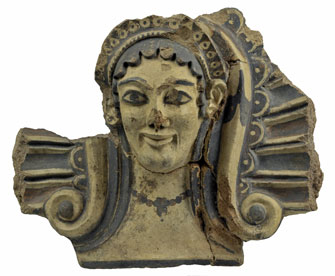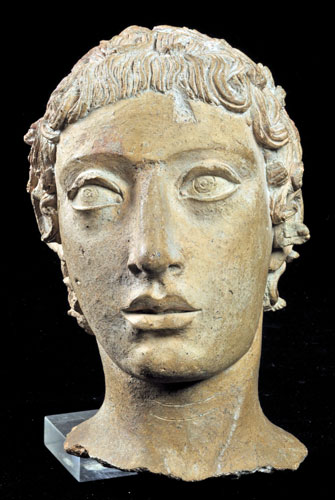Dead or Alive:
A Fascinating Culture

Antefix with the head of a maenad. Veio, late sixth century B.C.E. Su concessione della S.B.A.E.M. Museo Nationale Etrusco di Villa Giulia, Rome. Fabio Barbieri
The rich culture of the Etruscans, the people who inhabited part of the Italian peninsula from the ninth to first centuries B.C.E., may have been absorbed by the Romans, but it never really disappeared. It lies buried deep in today’s Italian culture and psyche.
“Buried” is the key word here, since most of what we see in exhibitions about the Etruscans comes from tombs and burial sites. Anyone who has seen the hundreds of carved cinerary urns at the Guarnacci Etruscan Museum in Volterra, Italy, or the statues of loving couples reclining on funeral monuments at the Villa Giulia in Rome or the Louvre in Paris will never forget them.
The exhibition “Etruscans: A Hymn to Life” at the Musée Maillol in Paris takes a different tack, attempting to bring the vibrant culture of the Etruscans back to life through their arts (frescoes, sculptures, gold and silver jewelry) and the implements of daily life (candlesticks, strainers, cookware, amphorae, andirons, etc.). These seafaring traders who admired the arts and architecture of Greece accumulated great wealth and enjoyed showing it off in luxurious appointments, many of which can be seen among the 250 pieces on show in the exhibition.
While the precise origins of the Etruscans and their language remain something of a mystery (whether they were an indigenous people or came from the Near East is still being debated), their culture is fairly well documented through the artifacts they left behind and some contemporary writings. With their hedonistic lifestyle and great love for food and drink, they had something of a bad rep in the ancient world, in part because Etruscan women played an important role in society and were allowed to attend banquets and symposia (the parties held after banquets) and even sit beside men and drink with the best of them. Roman and Greek women had no such privileges, and such behavior was considered shocking by the Etruscans’ neighbors. Homosexuality and sadomasochistic behavior were known to be practiced, the latter seen in frescoes found in today’s Tarquinia.
Other naughty activities and erotic states are depicted in works shown in a special display case in one of the upstairs rooms of the exhibition. One vase sprouts multiple phalluses, while a bowl illustrates various sexual positions. Another shows a man sitting on the ground with an erection while peeking under a woman’s skirt.
The show may be about the lifestyle of the Etruscans, but death is part of life, and there are inevitably a number of funerary pieces here, many of which served as sources for assumptions of what daily life was like for the Etruscans.
While many Etruscan pieces have an archaic look to them, the show demonstrates that they were also capable of refined, naturalistic representations in art. Examples here are the head of a man (perhaps a prince) in wood (probably once gilded) dating from the seventh century B.C.E., and a series of terra cotta ex-votos, notably “Malavoto” (430-400 B.C.E.), the lovely head of a boy with rosebud lips,

“Malavoto.” Veio, 430-400 B.C.E. Su concessione della S.B.A.E.M. Museo Nationale Etrusco di Villa Giulia, Rome. Fabio Barbieri
and a bronze head of a boy from the fourth century B.C.E.
The show gives a necessarily fragmented view of the lives of the Etruscans, but is a fine appetizer to further study of this mysterious “lost” culture.
Musée Maillol: 61, rue de Grenelle, 75007 Paris. Métro: Rue de Bac. Tel.: 01 42 22 59 58. Open daily, 10:30am-7pm (until 9:30pm on Monday and Friday). Admission: €13. Through February 9, 2014. www.museemaillol.com
Click here to read all of this week’s new articles on the Paris Update home page.
Reader reaction: Click here to respond to this article (your response may be published on this page and is subject to editing).
Please support Paris Update by ordering books from Paris Update’s Amazon store at no extra cost. Click on your preferred Amazon location: U.K., France, U.S.
More reviews of Paris art shows.
© 2013 Paris Update
Favorite